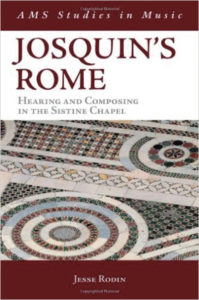©2012 Oxford University Press
Book review by Dr Debra Shearer-Dirié
The magnificent Sistine Chapel, originally known as the Cappella Magna, takes its name from Pope Sixtus IV. Designed for Pope Sixtus by Baccio Pontelli, construction on the building began in 1473, on the site of the original Cappella Maggiore. The first mass was celebrated in 1483, after the impressive frescos depicting the Life of Moses and the Life of Christ had been completed. In the early 1500s, Michelangelo painted the ceiling of the Sistine Chapel. This space, filled with these inspiring pieces of visual art, soon became the focus for innovative musical thought in the region. Josquin would have been approximately 30 years of age when the Chapel was completed and he became an integral part of this world, singing and composing for the Pope’s private choir. Josquin’s Rome sheds new light on the composer’s work and refers both to surviving manuscripts and new thinking from scholars, who consider the composer’s life and work.
Jesse Rodin, Associate Professor of Music at Stanford University and Director of the Josquin Research Project, examines Josquin’s contribution to this world. Rodin has been widely published on music of the Renaissance. In 2010, he received the Noah Greenberg Award in recognition of his work combining scholarship and performance. Music from his ensemble Cut Circle, which is also features as a part of Josquin’s Rome, is available from Musique en Wallonie.
Rodin examines every detail of the sources that we have at our disposal today, piecing together manuscripts from the Sistine chapel with the common compositional traits of the composers that are present in these anthologies. In Josquin’s Rome, Rodin sheds light on the repertoire performed by Josquin and his colleagues in the papal choir. Comprising the single largest surviving collection of late fifteenth-century sacred music, this gives us insight into the musical, social, and political issues of the period.
Part of the “AMS Studies in Music” series, in this volume Rodin uses a comparative approach to reveal this rich musical tradition in detail. Compiled in three parts, Josquin’s Rome explores different aspects of Josquin’s compositions, as well as those of his contemporaries. Part I – “Toward Josquin’s Style” – begins by assessing the problems surrounding the interpretation and analysis of Josquin’s music. The compositions that are analysed in this section are those that Josquin is most likely to have composed while singing in the papal choir. In referring to “Josquin’s Roman music,” Rodin concludes (through a detailed analysis, moving from line to line rather than piece by piece) that a collection of nine works can conceivably be associated with Josquin’s tenure in the Cappella Sistina. Part II – “Surveying the Soundscape: The Cappella Sistina, ca. 1480-ca. 1500” – takes a broader view and considers music by other composers whose works appear in the surviving manuscripts. Works by Gaspar van Weerbeke, Bertrandus Vaqueras, Heinrich Isaac, Johannes Tinctoris, and Marbrianus de Orto are covered in this section of the book. Questions are also posed as to the methods through which the Chapel collected music during this period, as well as how much of its repertoire may have been lost. This section refers constantly to an appendix that chronologically presents all of the music copied in Rome during this period. Part III – “Josquin’s Roman Music in Context” – turns its focus back to Josquin and explores the connections between his music and that of his contemporaries.
Central to Rodin’s thought is the idea that these pieces lived in performance. The author has put his interpretations of these pieces into practice with a series of recordings by his ensemble, Cut Circle (available both on the companion website and as a CD from Musique en Wallonie).
This book is an important resource for musicologists, musicians, and all early music enthusiasts. It covers the works Josquin composed during his time at the Papal court in great detail and shares the author’s insight as to how this music works melodically, contrapuntally, mensurally and structurally. Josquin’s Rome recreates the artistic world of this great composer at one of the pinnacles of his career.
Edited by Laura Clarke, UK


